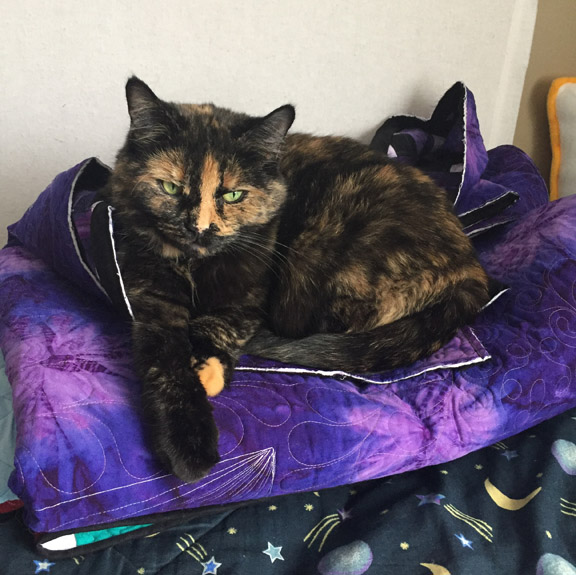Historical quilts and textiles are one of my passions and last summer I had the chance to see a truly amazing piece of quilting and patchwork history!
The 1718 Coverlet is the oldest dated patchwork in the United Kingdom, that we know of at this point anyway. The piece is made predominantly from silk and is pieced over papers which are still intact in the coverlet, a process that we refer to as English Paper Piecing today. It is not quilted, hence the reason why it is called a coverlet and not a quilt.
The piece is currently a part of the British Quilters’ Guild collections. The Guild purchased it at auction in 2000 and has been studying the piece ever since. At the time that it was purchased, the coverlet was owned by the Brown family of Aldbourne, England, and it is assumed to have been made by a member of that family. Unfortunately, even though the piece also contains the initials E. H. in the dated block, no one has yet been able to find an E. H. in the Brown family history who might have been the maker or recipient of the coverlet. It is unfortunately a good example of how, even when historians have provenance information, a date, and initials, the knowledge of who made the piece and why is easily lost.
Even though we do not know who made it, this piece is a key element in my own quilt history research because of its arrangement in a medallion-style layout and its use of block patterns that also appear in colonial and early American quilts. I have conducted research with the British Quilters’ Guild collections in York, England, before, but the coverlet was too fragile for me to see it in person on those research trips. I have written about the piece (see the Learn More section below) but was only able to study it through photographs and the writings of others. So when I heard it would be on display last year for its 300th birthday I knew I had to find a way to see it!
The quilt was on display at the American Museum in Bath during July 2018 and I definitely bought a plane ticket just to see it in person. The quilt was displayed in the Folk Art Gallery on a raised dais in the middle of the room. It was covered with a sheet of archival plastic to protect it and the room was staffed by volunteers to keep an eye on it and the other fantastic works on display. The plastic unfortunately meant that there was always a glare on the piece from the lights but the ability to get right up next to the coverlet was wonderful and amazing! They even had magnifying glasses available so that you could examine the details up close.
I teared up when I entered the room and first saw it. There’s nothing like seeing something that has had a profound impact on your career and research for the first time. I did go and enjoy the rest of the museum as they had a great exhibition on WWI, period rooms, and more quilts on display elsewhere, but I also kept coming back to the 1718 Coverlet to see it again and again.
Here are a few detail photos of my favorite blocks:
The signature block containing the date “1718” and the initials “EH” is set next to a heart block and above two blocks depicting an man and woman. The fabric in the date block is very worn.
The swans at the bottom of the quilt have great detail!
Bells or birds? You decide which image you see first in this block.
The maker(s) of this quilt did a lot of fussy cutting and careful piecing to create effects like the radiating squares found in the center of one of the modified nine-patch blocks.
I love cats so I really enjoy this block depicting a cat with a fish in its mouth! It is one of many different typical English farm animals pictured in the coverlet.
This block shows where fabric has worn away, revealing the papers used to piece the quilt. This paper scrap seems to have come from a ledger.
For those of you who didn’t get to see the original on display, the British Quilters’ Guild has actually made a replica of the coverlet, serving as both a research project and as a display piece that shows what the coverlet likely looked like when it was first made. In its current condition many of the fabrics have faded, disintegrated, or have lost portions of the design in the fabrics themselves but the replica lets us appreciate what the piece would have looked like when it was first constructed.
While the original 1718 Coverlet is now safely back in storage, there are still lots of ways to learn more about it and even make your own! You can check out the resources below and also learn more about the coverlet and its importance in quilt history by booking me to come give an illustrated lecture on “The History of the American Block-Style Quilt” to your group!
Learn More
There is a lot of information on the 1718 Coverlet if you want to learn more. Here’s where to find it!
For a brief overview:
The Quilters’ Guild. “The 1718 Silk Coverlet,” June 12, 2009.
The Quilter’s Guild Blog. “The 1718 Silk Patchwork Coverlet,” September 27, 2022.
For in-depth research:
Janice E. Frisch. “British Influences on the American Block-Style Quilt.” Quilt Studies: The Journal of The British Quilt Study Group, issue 15 (2014): 34-65.
- Currently available for purchase from the British Quilters’ Guild. This article by me talks about the layout and design of a few key British pieces and their influence on what would become an iconic American quilt layout. The 1718 Coverlet is one of those pieces. I also discuss this piece in my talk on “The History of the American Block-Style Quilt.”
Bridget Long. “Uncovering Hidden Marks on the 1718 Silk Patchwork Coverlet.” Quilt Studies: The Journal of The British Quilt Study Group, issue 9 (2008): 62-83.
- This issue is also out of print but check your libraries and look for used copies that occasionally pop up on Amazon. You may also be able to get a copy of the article via Interlibrary Loan.
Dorothy Osler, ed. Quilt Studies: The Journal of The British Quilt Study Group, issue 4/5 (2002/2003).
- Issue 5 was a special issue devoted entirely to the 1718 Coverlet with articles on the piece’s provenance and history of the Brown family, the fabrics in the coverlet, the social and economic context in which it was made, and a comparison with other contemporaneous textile techniques. This issue is currently out of print but check your libraries and look for used copies that occasionally pop up on Amazon.
Make your own version:
Susan Briscoe. The 1718 Coverlet: 69 Quilt Blocks from the Oldest Dated British Patchwork Coverlet (David & Charles, 2014).
- This book contains patterns and template to make your own versions of the blocks. It also has overview sections on the research that has been done on the coverlet as well as the making of the replica.
Photo Credit: The 1718 Coverlet photo is courtesy of the Quilters’ Guild Museum Collection. All other photos by author.














Leave a comment